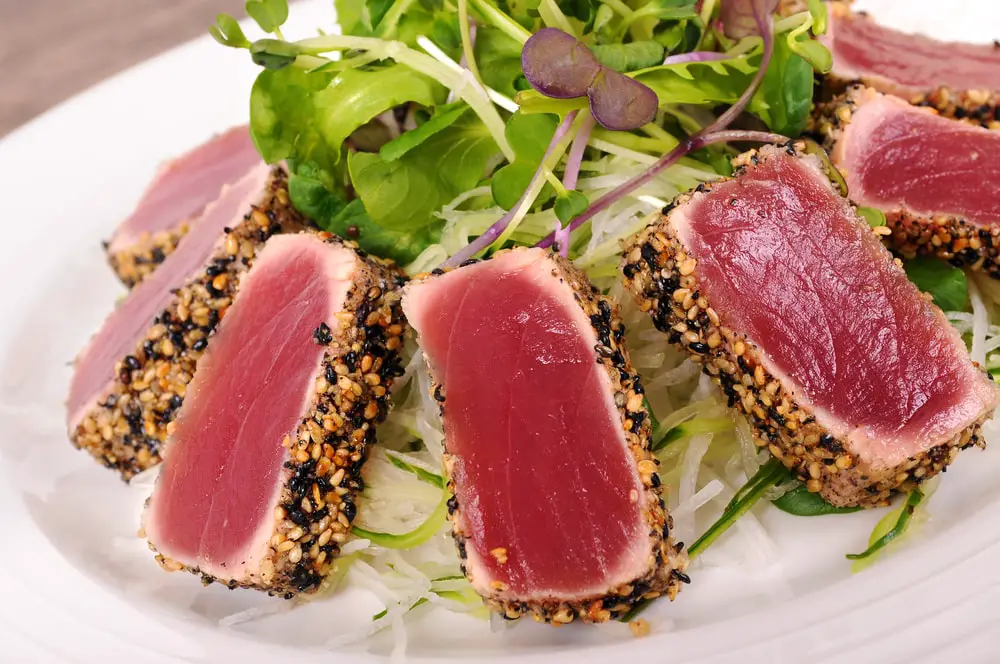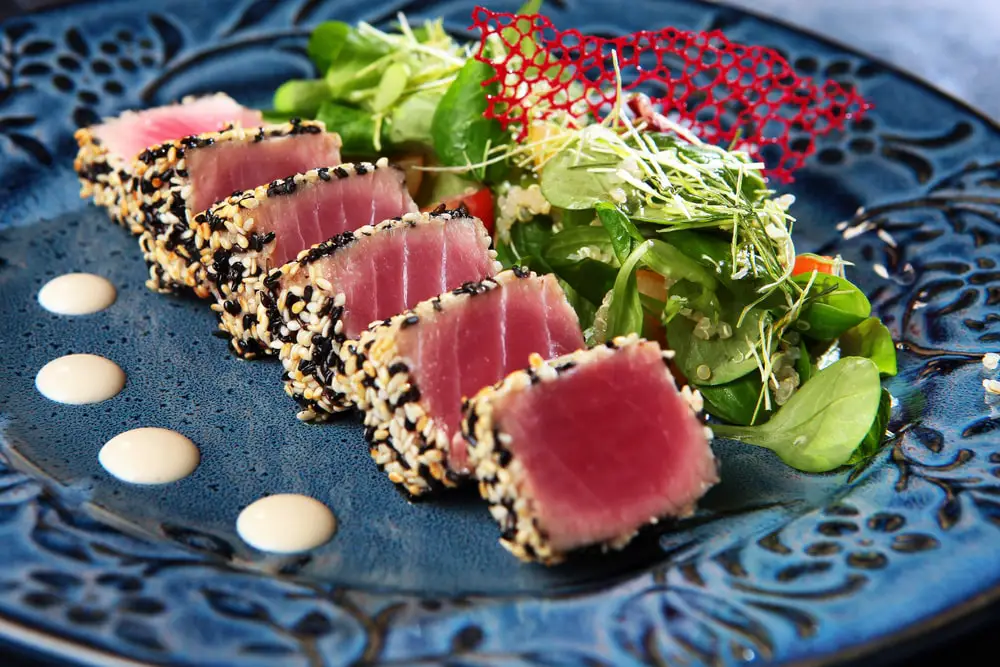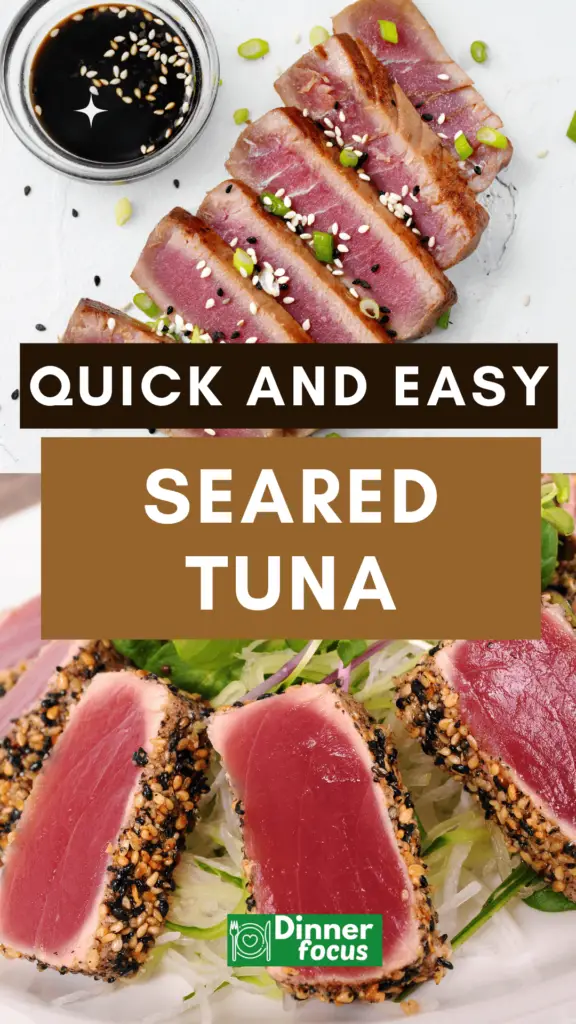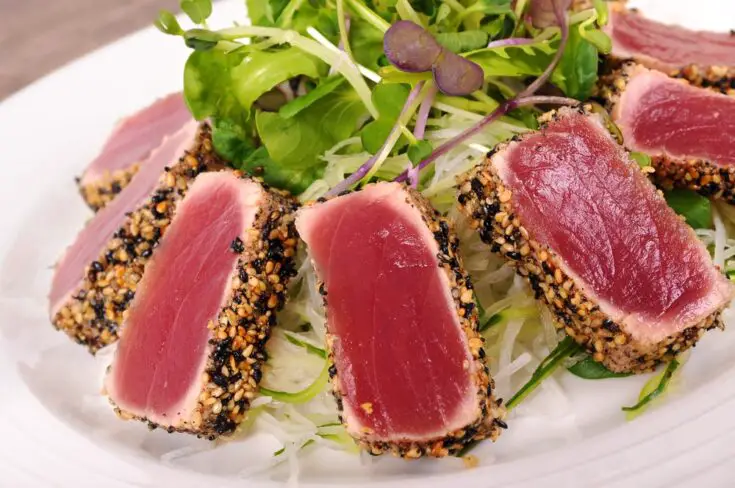Seared Tuna : Perfectly golden on the outside with a tender, melt-in-your-mouth center, the quick sear locks in the natural richness of the tuna, while a zesty soy-citrus glaze adds a tangy, savory kick. Pair it with a crisp side salad or steamed jasmine rice.
What is Seared Tuna?
Seared tuna, often made with ahi tuna steaks, is a dish where the fish is quickly cooked at high heat, leaving the inside rare or raw. This technique results in a delicious contrast: a smoky, caramelized crust on the outside and tender, buttery fish within. The short cooking time preserves the tuna’s texture and fresh, slightly sweet taste, making it a favorite in Japanese cuisine and a staple in poke bowls, sushi, and sashimi.

Tips and Tricks for the Best Seared Tuna
- Don’t Overcook: The hallmark of great seared tuna is the rare, almost raw center. Avoid the temptation to cook it through—it will become tough and lose its unique flavor.
- Get the Pan Hot Enough: A hot pan is essential for a quick, even sear. If the pan isn’t hot, the tuna will cook more slowly and won’t develop that beautiful crust.
- Use High-Quality Oil: Olive oil or sesame oil works well due to their flavors and ability to withstand high heat. However, avoid oils with low smoke points, as they can burn quickly.
- Knife Skills: Use a sharp knife to slice the tuna for the cleanest cuts. Slicing against the grain also helps the tuna stay tender and prevents tearing.
Flavor Variations
- Sesame-Crusted Tuna: Coat the tuna in a blend of white and black sesame seeds before searing for an extra layer of flavor and crunch.
- Spicy Tuna: Add a pinch of cayenne pepper or chili flakes to the seasoning mix for a spicy kick.
- Garlic-Herb Seared Tuna: Rub minced garlic and fresh herbs like rosemary or thyme onto the tuna before searing for a Mediterranean twist.
- Citrus-Marinated Tuna: Marinate the tuna in lemon or lime juice for 10–15 minutes before searing for a tangy, fresh flavor.

How to Serve Seared Tuna
Seared tuna is incredibly versatile and can be enjoyed in various ways. Here are some delicious serving ideas:
- As a Salad Topper: Serve seared tuna atop a fresh salad with greens, avocado, cherry tomatoes, and a soy-ginger dressing.
- In a Bowl: Create a poke or sushi bowl by serving seared tuna over rice with veggies, edamame, and a drizzle of spicy mayo or ponzu sauce.
- With Dipping Sauce: Pair with soy sauce, wasabi, and pickled ginger for a sushi-style experience. Or try it with a garlic aioli, teriyaki glaze, or even a simple lemon-olive oil dressing.
- Taco Style: Slice thinly and layer into corn tortillas with slaw and a zesty lime crema for a delicious twist.
How to Store Seared Tuna
Storing seared tuna is simple but requires a bit of care:
- Refrigerate: If you have leftovers, place them in an airtight container and refrigerate for up to 2 days.
- Freeze: Although fresh seared tuna is best, you can freeze it by wrapping it tightly in plastic wrap, then placing it in a freezer-safe bag. It can last up to 3 months, but the texture may be slightly compromised.
Reheating Tips: To avoid overcooking, it’s best to eat seared tuna cold or at room temperature. If you must reheat, do so gently in a skillet for just 30 seconds on each side.

Recipe FAQs
Can I make seared tuna with frozen fish?
Yes, but make sure it’s properly thawed and pat it dry before cooking. Opt for sushi-grade frozen tuna whenever possible.
How can I tell if the tuna is sushi-grade?
Most reputable fishmongers or stores will label sushi-grade fish. If in doubt, ask, as it indicates the fish was frozen to kill parasites, making it safer for raw or rare consumption.
What side dishes pair well with seared tuna?
Seared tuna pairs well with light, fresh sides like seaweed salad, roasted vegetables, or even a simple rice dish. Cucumber salad or soba noodles make great accompaniments, too.
Is seared tuna safe to eat rare?
When prepared with sushi-grade fish, seared tuna is safe to eat rare, as it meets high standards for freshness and handling.
Can I make this dish ahead of time?
Seared tuna is best enjoyed fresh, but you can prepare it ahead and serve it cold or room temperature. Avoid reheating to maintain the tender texture.
Seared Tuna

Seared Tuna : Perfectly golden on the outside with a tender, melt-in-your-mouth center, the quick sear locks in the natural richness of the tuna, while a zesty soy-citrus glaze adds a tangy, savory kick. Pair it with a crisp side salad or steamed jasmine rice.
Ingredients
- 16 oz ahi tuna (sushi-grade saku block), thawed
- 2 tbsp high-heat oil (peanut, wok, or avocado oil)
- 1 tbsp soy sauce (or GF liquid aminos)
Sesame Crust:
- 3 tbsp sesame seeds (black or a mix of black and white)
- 1 tsp cracked black pepper
- 1 tsp garlic powder (or onion powder)
- 1 tsp kosher salt
- 1 tsp dried thyme
- 1 tsp sugar
Instructions
- Combine sesame seeds, garlic powder, salt, pepper, sugar, and thyme in a small bowl.
- Pat the tuna dry with paper towels. Place it on a plate and coat all sides with soy sauce to help the sesame crust stick.
- Generously sprinkle the sesame mix over all sides of the tuna, pressing it down to adhere.
- Get your cast-iron skillet super hot over medium-high heat. This step is key for a great sear, so be patient until it’s very hot. Turn on your fan, and have your tongs, spatula, and splatter guard handy.
- Add oil to the pan, letting it heat up until shimmering. Carefully place the tuna in the skillet, pressing it down slightly with a spatula.
- Place the seared tuna on a cutting board and blot if desired. Using a very sharp knife, thinly slice the tuna.
- Serve immediately or refrigerate for up to 3 days if you prefer it chilled.
Nutrition Information
Yield
4Serving Size
1Amount Per Serving Calories 254Total Fat 11gSaturated Fat 1gTrans Fat 0gUnsaturated Fat 9gCholesterol 53mgSodium 597mgCarbohydrates 4gFiber 1gSugar 1gProtein 35g
Easy Shrimp Recipes.com, occasionally offers nutritional information for recipes contained on this site. This information is provided as a courtesy and is an estimate only. This information comes from online calculators. Although allchickenrecipes.com attempts to provide accurate nutritional information, these figures are only estimates.
Final Thoughts
Mastering seared tuna is easier than it may seem, and once you have the basics down, it’s a versatile dish you can customize to your taste. From the melt-in-your-mouth texture to its rich, savory flavor, seared tuna can elevate any meal. So grab a sushi-grade tuna steak, fire up your pan, and enjoy the restaurant-quality experience right in your own kitchen!
Try these other tuna recipes:
